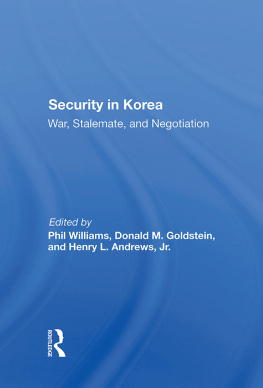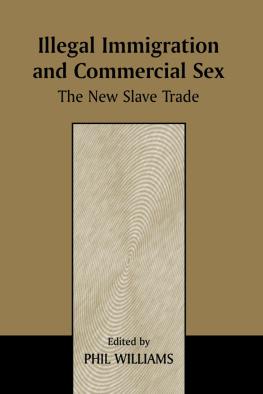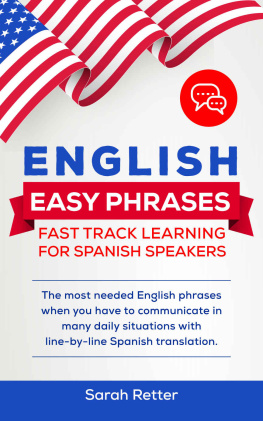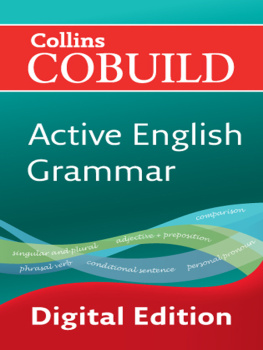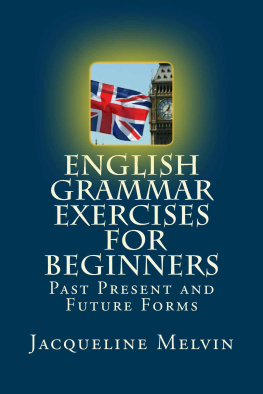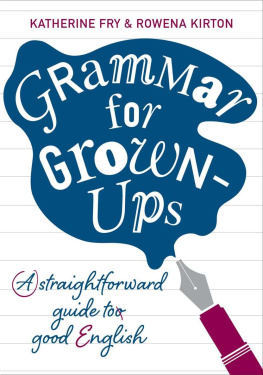The English Tenses
Practical Grammar Guide
Phil Williams
Preface
This textbook is for English learners at Intermediate and Advanced levels, and above. It provides a deep understanding of the English tenses, considering grammar and practical use. It is a guide to all the time-based tenses, including their non-time-based uses, which will help you to use the English tenses in different, and more natural, ways.
The Kindle version of this book has been optimised to get you straight into the topic youll find indexing and a discussion of forms at the back of the book.
Introduction
This guide will take you through the English tenses from Past , to Present , to Future , with each section covering four main forms (Simple, Continuous, Perfect and Perfect Continuous). There are initial notes on grammatical form, examples for each form to demonstrate use, and detailed explanations for both the rules and the practical uses of the tenses.
These explanations are designed to help you learn the specific English grammar rules for the tenses and to identify common (often more flexible) usage. The complexity of the tenses and their uses often arises from native English speakers ability to bend the rules of the language. In many cases the rules give way to general patterns, which can be difficult to master this book is designed to help.
What are the English Tenses?
Time in the English language is essentially shown using twelve distinct grammatical structures, referred to as the tenses : four for the past , four for the present and four for the future .
These twelve tenses can be used for many different purposes. Because of these different uses, they are often called aspects rather than tenses . For the sake of simplicity, this guide will discuss these different grammatical forms (aspects) as tenses .
The tenses tell us about the specific points in time of actions, events and states. These can be summarised with short grammatical rules, but (as is true with much of the English language) these rules have many exceptions, and do not tell the whole story. This is because English in practical use is always changing, and English is spoken so widely that different uses emerge from different regions. It is also because over time English has evolved to be used in particular ways, with ingrained exceptions to even the most simple rules.
For example, the present simple normally represents a timeless fact, for instance heated water boils, but it can also be used to talk about conditions in the present moment, such as I feel happy now. (A use that is explained in .)
This guide is designed as a complete comparison of the tenses to help explain where these exceptions emerge, why certain tenses can be used in different ways, and how to choose between similar uses.
How to use this book
This guide offers explanations of form, examples of form and explanations of comparative uses for each tense. You can read the sections individually to learn about different aspects of English, or you can read the book in order, to get an overall understanding of the tenses. The guide is designed to be read in full, but you may choose to use it for reference.
The guide begins with an explanation of the general rules of Form , to show how the different tenses are constructed. Each section then presents the Affirmative (Positive) , Question , Negative , and Negative Question forms of a tense, putting the form rules into practice with numerous examples.
Following the form examples, the different uses of each tense are explained, followed by notes on how the uses relate to other tenses. These parts will help you understand the unique functions of the tenses, so you can choose between the tenses in everyday use.
In many cases, this goes beyond the basic single-use rules you may find in other textbooks, to show both the pure grammatical purposes of the tenses and the other ways that native English speakers use them.
There are regular examples and illustrations to aid understanding, with a glossary of grammar terms and additional information in . The examples used are deliberately varied and often unconventional, so carefully comparing the uses and examples (including those in the form tables) may help test your understanding of the information offered here.
There are no exercises in this book, but you may be interested in pairing this self-study with The English Tenses Exercise Book, which is designed to specifically drill understanding of this guide.
Please note that this guide is written in British English. Although some consideration has been given to the differences between British and American English, it may still contain regionally specific language.
Colour coding
For e-readers that support colour, this guide is colour-coded to highlight important grammar points, structure and examples.
- Listed examples are given with bullet points.
- Italics show examples within the main body of the text, or additional information in listed examples.
- Bold black is used for structure and form.
- Orange highlights grammar rules and words of importance.
- Blue words are clickable links to useful sections in the guide or online.
The Past

Events, actions and states described by the past tenses are usually finished, or were interrupted in the past, and do not directly affect the present moment.
Using the past, you can talk about complete events, events that were completed before other events, and events that were ongoing or interrupted at specific times before now.
- Something happened.
- Something was happening at a certain time in the past.
- Something had happened before another past event.
- Something had been happening before another past event.
These different tenses give you the ability to explain the past in sequences, and help you to relate different past events to each other.
The Past Simple
1. Past Simple Form
1.1 Past Simple - Affirmative Form
Subject | Verb | Additional information |
I | liked | that class. |
You | helped | me learn a lot. |
We | planned | to visit Croatia. |
They | dreamed | of a better tomorrow. |
He | whistled | very loudly. |
She | worked | all night. |
It | sounded | horrible. |
Martha | played | football. |
1.2 Past Simple - Question Form
Question Word | did | Subject | Bare Infinitive | Additional information |
What | did | I | come | here for? |
Did | you | like | the film? |
Did | we | win? |
How | did | they | know | we would be there? |
Where | did | he | go? |
Why | did |
Next page



